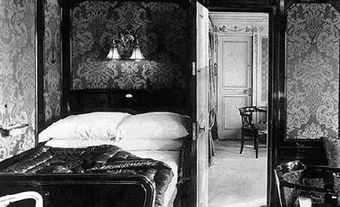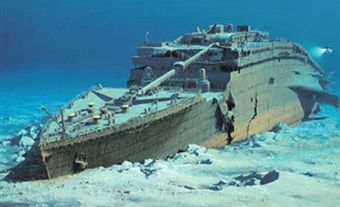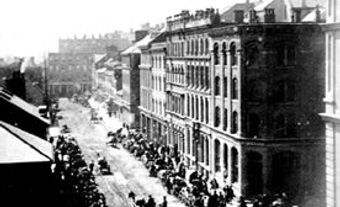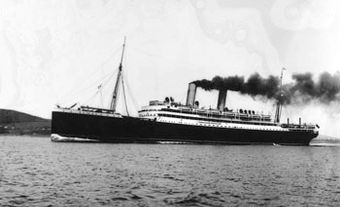The Royal Mail Ship Titanic sank on 15 April 1912, taking the lives of more than 1,500 passengers and crew. Many victims went down with the ship, but the bodies of others remained on the surface, kept afloat by their life jackets. Pressure from relatives, newspapers and the general public led the Titanic’s owners, the White Star Line, to charter four vessels to recover the victims’ bodies. In total, these ships recovered the bodies of 328 passengers and crew. The recovery effort was based in Halifax, Nova Scotia, where 150 of the victims were buried.

Recovery Operations
Although St. John’s, Newfoundland, was closer to the site of Titanic’s sinking, White Star Line officials decided to mount the recovery operation from Halifax, Nova Scotia. Unlike St. John’s, which was difficult to reach, Halifax had rail connections to the major cities of eastern North America, making it easier for relatives to travel there to identify remains and transport them home if desired. The city also had more undertakers.
Mackay-Bennett
During the evening of 16 April, the White Star Line representative in Halifax chartered the steam-driven CS (Cable Ship) Mackay-Bennett to recover as many bodies as possible. Owned by the Commercial Cable Company, the ship’s normal job was to lay and repair the company’s transatlantic undersea telegraph cables. Only crewmen who had volunteered for “work that was unsettling” were allowed to participate in the recovery mission.
When Mackay-Bennett departed, it carried 125 rough-hewn coffins and all the embalming fluid in the city (enough for 70 bodies). Several tons of ice were brought aboard to preserve bodies if the embalming fluid ran out. The ship also carried canvas and scrap iron weights for burials at sea.
On 17 April at 12:28 p.m., Mackay-Bennett departed Halifax under command of Captain Frederick Larnder (frequently misspelled Lardner). Besides the crew, a Protestant clergyman and an embalmer were also aboard. Several newspapers called the vessel the “Ship of Death.”
Recovery Begins
Mackay-Bennett reached the area of Titanic’s sinking on the evening of 20 April. Recovery operations began the next morning at 6:00 a.m. Lookouts on the bridge and bow scanned the sea for bodies, described by Captain Larnder as looking like “a flock of sea gulls” because of their white life preservers. When bodies were seen, two or more of the ship’s cutters were lowered over the side and rowed to the site. The bodies were then brought aboard the cutters, which transferred them to Mackay-Bennett before repeating the process. Crew aboard Mackay-Bennett numbered the bodies and personal effects, which were then examined by undertakers and their assistants.
The decision was then made either to bury the victim at sea or bring them to Halifax. While no detailed records exist, such decisions were likely based on the following criteria: whether the body could be identified, the physical condition of the remains and the individual’s social class. The class of the passenger also seems to have influenced the decision. During its 13 days at sea, Mackay-Bennett recovered 306 bodies. Of these, 116 were buried at sea and 190 taken to Halifax.

Minia
It soon became clear that another recovery ship was needed, and the White Star Line chartered the CS Minia, owned by Western Union and captained by William deCarteret. Minia departed Halifax on 22 April and carried 150 coffins, 20 tons of ice and 15 tons of scrap iron, as well as a Protestant clergyman and embalmer.
Minia arrived in the search area on 26 April, but bad weather hindered the search. Many bodies had also been swept away in the Gulf Stream by then and were found more than 240 km from where Titanic sank. After a week, only 17 bodies, all male victims, had been recovered. Two were buried at sea and the others taken to Halifax on 6 May. One of the bodies was that of Charles Melville Hays, president of the Grand Trunk Railway. At Halifax, the crew transferred its unused coffins and embalming fluid to a third recovery ship, the steamship Montmagny.
Montmagny
The Canadian Government Steamship Montmagny was a lighthouse supply and buoy tender operated by the Department of Marine and Fisheries. Under the shared captaincy of Peter Johnson and François-Xavier Pouliot, Montmagny sailed from Halifax on 6 May with a Protestant and a Catholic clergyman and two undertakers on board.
Despite poor sea conditions, Montmagny recovered four bodies. The crew buried the first one at sea on 9 May and delivered the other three to Louisbourg on Cape Breton Island on 13 May. From there, they were shipped to Halifax by rail.
Montmagny refuelled and resupplied before it returned to the search zone. Although the ship crisscrossed the area, it did not find any more bodies. On 19 May, the fourth ship, Algerine, showed up, and Montmagny returned to Halifax on 23 May.
Algerine
The last of the four ships chartered by the White Star Line was the steamship Algerine, a civilian cargo and passenger ship and part-time sealer owned by Bowring Brothers of St. John’s. Coincidentally, the firm that built Titanic, Harland and Wolff, had also constructed Algerine. The ship sailed from St. John’s on 16 May under the command of Captain John Jackman, with two undertakers onboard.
After Algerine rendezvoused with Montmagny, it continued the search for another three weeks but found only one body, that of a saloon steward. Algerine brought his remains back to St. John’s on 6 June; they were transferred to the steamer Florizel, which sailed to Halifax, arriving on 11 June.

Did you know?
Another nine bodies were recovered by RMS Carpathia and by passing ships. The first were picked up by Carpathia, which sailed to the area upon receiving Titanic’s distress call and found its lifeboats, which were scattered over a wide area. Although 713 passengers and crew were saved, the lifeboats also contained three bodies and one survivor who died after being brought aboard; all four were buried at sea. Passing ships also found a total of five bodies, the last one on 8 June. In total, 337 bodies of passengers and crew were recovered, with 128 buried at sea.

Halifax
Mackay-Bennett steamed into Halifax harbour at 9:00 a.m. on 30 April. As the ship made its way up the harbour, church and fire bells tolled, and flags flew at half-mast as spectators quietly lined the waterfront and stood on Citadel Hill or rooftops. Many local businesses had draped their windows in black, and some displayed framed photographs of Titanic. After the ship docked in the naval yard, bodies were loaded into horse-drawn hearses, which took most of them to a temporary morgue in the Mayflower Curling club. Forty additional embalmers came to Halifax from across the Maritimes, including two women who embalmed all the females and one child, known as the “Unknown Child.” In total, 150 victims were buried in Halifax; another 59 were sent elsewhere for burial, as requested by family members.
Cemeteries
Solemn funeral services were held in five Halifax churches and were well-attended by Haligonians; several memorial services had been conducted even before victims’ remains arrived in the city. The White Star Line arranged for burial plots in three of the city’s cemeteries and also paid for standardized headstones, although families could pay for more elaborate ones. In all, 121 remains were buried in the nondenominational Fairview Lawn Cemetery, 19 in the Catholic Mount Olivet Cemetery and 10 in the Jewish Baron de Hirsch cemetery. The cemeteries are the largest and most visible reminder in the world of one of history’s best-known disasters and are visited by thousands of people each year.
Titanic Sites
There are many sites in Halifax associated with Titanic, besides the three cemeteries. They include the Maritime Museum of the Atlantic, which has a unique collection of Titanic artifacts, especially wooden ones. The Nova Scotia Archives hold the original documents concerned with the recovery and identification of Titanic victims.
Other locations include the houses of the two Titanic passengers from Halifax (George Wright and Hilda Slayter), the former curling club that was used a morgue (now an army surplus store) and four of the five churches (one was destroyed in a 1979 fire) in which funeral services were conducted.


 Share on Facebook
Share on Facebook Share on X
Share on X Share by Email
Share by Email Share on Google Classroom
Share on Google Classroom





